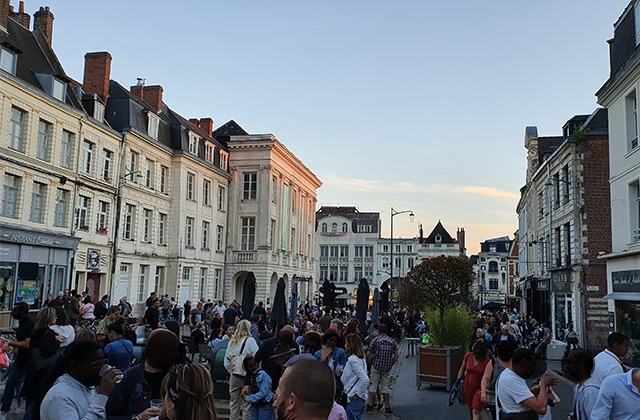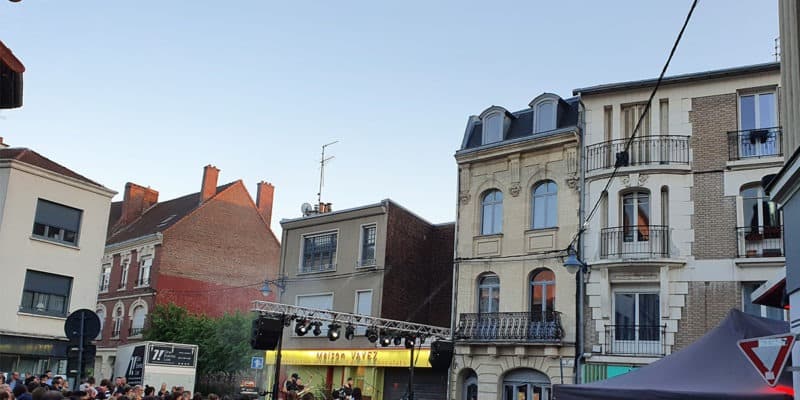The Fête de la Musique d’Arras took place on Tuesday June 21. After two years marked by health restrictions, here’s the program in pictures for this 4th year of existence, unfortunately marred by breakdowns during the COVID. Here’s a look back at an event that kept the people of Arras on the edge of their seats until one o’clock in the morning.
The program in detail in Arras
Several events took place on different dates, including :
- Baroque music on June 19 with the Ensemble Vocal Ambian concert ;
- The Talents on Stage Concert on the same day ;
- A Fête de la Musique concert at La Malterie du Pavé on June 21.
In addition, many local (and non-Arrasian) bands gathered between rue Gambetta/ rue Saint Aubert and the Grand’Place d’Arras. Here’s an example from the Place du Théâtre, next to the Hôtel de Guînes, where a magnificent concerta also attracted a packed audience:  It wasn’t raining in Arras that day, and it was actually quite warm! The perfect opportunity to get out with family and friends and enjoy the atmosphere 🙂
It wasn’t raining in Arras that day, and it was actually quite warm! The perfect opportunity to get out with family and friends and enjoy the atmosphere 🙂
The origins of the “fête de la musique” in France and Arras
The origins of the fête de la musique, known as an annual celebration of music on June 21, can be traced back to 1982 when it was officially established by the French Minister of Culture, Jack Lang. His vision was to create a cultural event that would bring people together through the universal language of music. Since then, this festival has evolved into a global phenomenon, celebrated in nearly a hundred countries across the world. Millions of participants, ranging from anonymous music lovers to internationally renowned stars, join in the festivities every year.
In Arras, the fête de la musique holds a special place in the city’s rich cultural calendar. Arras has always had a deep connection with music and art, as seen in its historic squares and heritage sites. When the fête de la musique comes to life on the longest day of the year, the city’s streets, parks, cafés, and clubs are transformed into lively stages where both amateur and professional musicians showcase their talents. This event not only serves as an avenue for local musicians to express themselves, but also adds to the cultural vibrancy of Arras, attracting visitors from near and far.
The significance of the fête de la musique extends beyond just an entertainment event. It echoes the historical gatherings that Arras has been known for over the centuries. From medieval fairs to the bustling markets that have occupied the Grand Place and Place des Héros, Arras has always been a place where people come together to share in communal experiences. In a way, the fête de la musique continues this legacy by fostering a sense of unity and joy through the power of music.
Tourists from around the globe are drawn to France during this period, and cities like Arras become hubs of cultural exchange and celebration. The festival’s appeal lies in its open, inclusive nature; it welcomes anyone to pick up an instrument and join in, blurring the lines between professional performers and casual enthusiasts. This tradition of inclusivity has become a defining characteristic of the festival and has helped it to thrive for decades. In Arras, this has the added benefit of boosting local commerce, as cafés, restaurants, and shops see a surge in activity from the influx of festival-goers.
Adam de la Halle: the troubadour from Arras
There are a number of personalities associated with music in Arras, such as Adam de la Halle, a major local figure who was born in Arras and probably died in Naples. He was a 13th-century French composer, poet and musician. He is best known for his troubadour works, which satirize the conventions of courtly love. Adam also wrote poems and songs, some of which are still performed today. In addition to his musical works, Adam was also an accomplished philosopher and theologian. He exerted a major influence on the scholastic tradition of thought, and his writings helped shape the intellectual climate of medieval Europe. Adam de la Halle was a remarkable figure of the Middle Ages, and his life and work continue to fascinate scholars and music lovers alike.
X.D.
